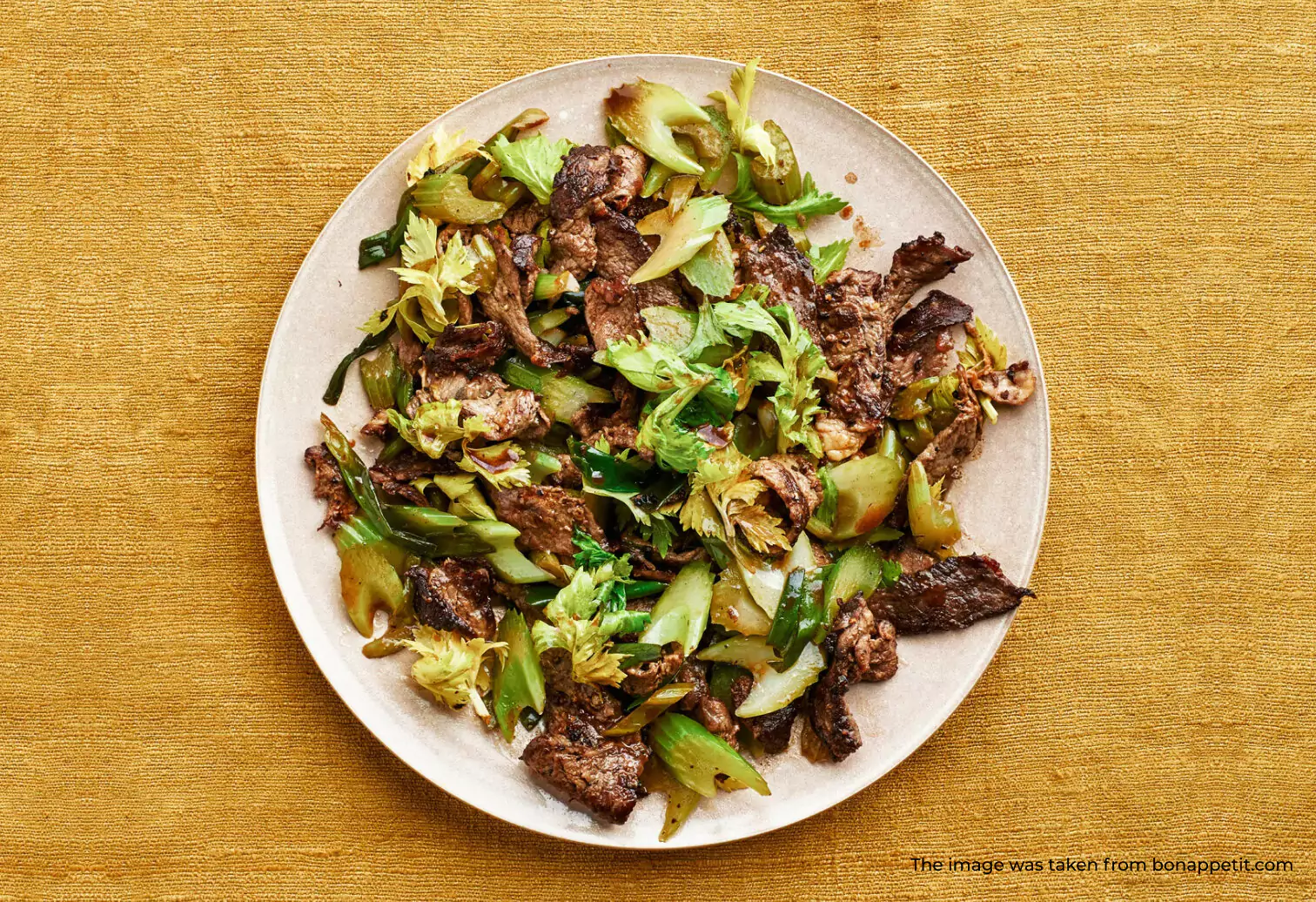Can Celery Help You Manage Your Blood Sugar Levels?

Key Takeways
Is celery just a crunchy side to your wings-and-blue-cheese dish or another raw veggie on your crudités tray? It deserves more love, given its numerous health benefits.
This humble green stalk is rich in nutrients that can support various health concerns. From gut health to diabetes management, it can be a helpful addition to your diet. And like cucumbers, celery has a lot of water content. It's made up of 95 percent water, so it may also be an excellent way to keep your fluids up.
Celery is touted for its beneficial effects on lowering glucose, but there is not enough research to confirm this. Researchers believe that the phytochemicals in celery may help increase insulin sensitivity and reduce inflammation, both of which are vital factors in maintaining healthy blood sugar levels. In one study, participants who ate two stalks of celery per day for four weeks saw significant improvements in their blood sugar control and insulin secretion levels.
Known scientifically as Apium graveolens, this herbaceous plant of the parsley family Apiaceae. It has a long history of use as a medicinal herb in practices like Ayurveda. Delving deeper into this topic is worthwhile given its potential benefits for blood pressure, cholesterol, and blood sugar levels. Keep reading to discover why incorporating it into your diet is highly recommended.
Is There Sugar in Celery?
Whole foods usually contain natural sugars, which don't have the same adverse effects on your health as the added sugar in processed food. Fruits contain natural sugar but they also contain fiber, micronutrients, antioxidants, and water. Most processed foods with added sugar are low in fiber and not nutrient-dense.
Although most fruits and raw vegetables contain naturally occurring sugars like sucrose, fructose, and glucose, not all are created equal. For example, tamarind and jackfruit are higher in sugar than mushrooms and tomatoes.
Where does celery stand on the sugar scale? Celery is a vegetable that is low in both calories and sugar content and high in fiber and water content. It's why it's often recommended as a snack for individuals looking to lose weight and people with type 2 diabetes looking to control their blood sugar levels within a healthy range or improve their diabetes complications.
One stalk of raw celery contains:
- Less than a gram of sugar
- Three percent of your daily fiber needs
- Six calories
- Vital nutrients like vitamins A, C, and K
The Effect of Celery on Your Blood Glucose Levels

So, we know that celery is full of health benefits, but can it help manage your blood sugar levels? Yes! One of the benefits of this vegetable is, in fact, its positive effect on your blood glucose levels.
Celery has a low sugar content and is low in digestive carbohydrates. These things mean it is not likely to cause blood sugar spikes for most people.
Celery also contains a compound called apigenin, which has been shown to help lower blood sugar levels, improve insulin resistance, and maintain healthy weight in mice. In addition, celery has enough fiber and other nutrients that may help regulate blood sugar levels.
A recent study found that participants who ate celery with their meals found that their postprandial blood glucose levels were 19.5 percent lower than those who did not. It makes celery an excellent food for people with diabetes or prediabetes.
So, when it's included as part of a balanced diet, it can help regulate blood sugar levels. Let's take a look at some of its other potential benefits.
The Benefits of Celery

Celery may not be as flashy as other vegetables, but it's more than just a side! It's a good source of dietary fiber, potassium, and vitamin C and has anti-inflammatory properties that can help fight off disease. So, consider incorporating the vegetable into more mains to reap its benefits. Here are some of its primary health benefits:
It Can Help Prevent Cardiovascular Disease
Celery is a powerhouse of nutritional value. It's a low-calorie, high-fiber option and a good source of potassium, vitamin K, and folate. It's also known for its ability to reduce blood pressure levels and improve heart health overall.
It Has Digestive Health Benefits
Celery is also known for its digestive health benefits. Some of the nutrients found in celery include fiber, potassium, and vitamin C. Celery is a good source of antioxidants, which can help protect the body against free radicals.
Additionally, celery contains natural compounds that can help support digestive health. When it comes to gut health, celery can:
- Potentially reduce your risk of stomach ulcers
- Promote digestive tract function which may improve other health conditions
- Reduce inflammation
- Decrease insulin levels
According to animal research, celery extract can help promote weight loss. Although more studies are needed to confirm the effects of celery on weight loss in humans, there is evidence that suggests incorporating this vegetable into your diet can aid in weight management.
It Can Strengthen Your Bones
Did you know that celery is also an excellent food for bone health? It contains high levels of magnesium, flavonoids, and Vitamin K, which are beneficial for bone health.
You need potassium to maintain bone mineral density, which is something else celery has to offer. It's safe to say adding celery to a balanced healthy diet can help keep your bones strong and healthy as you age.
It Helps You Stay Hydrated
Think of celery as nature's sports drink. This fibrous vegetable is mostly water (95 percent, as mentioned above), but that's not the only reason it helps with hydration.
It also contains essential electrolytes like sodium (in small amounts: a medium sized stalk has 32mg of sodium, for example) and potassium, making it an excellent option for pre-workout hydration. And the insoluble fiber in celery can help regulate blood sugar levels within normal range and promote gut health.
It Has Many Essential Vitamins
If you're looking for ways to increase your daily intake of vitamins, add some celery to your diet. Celery is a good source of vitamin A and vitamin C, which are essential nutrients that our bodies need to function correctly. In addition, celery is a low-calorie food, making it a healthy choice for those trying to lose weight or maintain their current weight.
It Has Anti-inflammatory Properties
One of the main benefits of celery is its anti-inflammatory properties. Inflammation is a major factor in many chronic diseases, so by consuming foods that have anti-inflammatory effects, you can help prevent these medical conditions. Celery is rich in antioxidants and phytochemicals, both effective at reducing inflammation in the body.
It Helps Regulate Blood Pressure
As we mentioned above, celery is filled with potassium. Potassium is an essential mineral that helps keep your heart healthy, promotes muscle functioning, and regulates blood pressure.
Celery also contains a phytochemical called phthalides that can help increase blood flow and reduce blood pressure. Celery seed extract, in particular, can help lower blood pressure.
{{rich-text-cta-cgm1="/style-guide"}}
The Side Effects of Overeating Celery

Are there side effects to overeating celery? Celery is a low-calorie vegetable with many health benefits and can improve overall wellness when part of a balanced diet. But as with most things, overeating can do more harm than good.
Remember that there's no one-size-fits-all for nutrition, so it's essential to monitor the effects of celery on your specific body. Here are a few common side effects some people may experience:
- Altered thyroid function
- Liver damage, kidney disease, and in extreme cases kidney failure, when consumed in excessive quantity for a long duration
- Bloating
- Diarrhea
- Gas
- Gastrointestinal issues
The Celery Juice Trend

The wellness world is abuzz with a delicious health trend: celery juice. Proponents of this new green juice fad claim that drinking celery juice first thing in the morning can help improve digestion, boost energy levels, help with weight loss, and clear up skin problems.
You may have noticed the recent celery juice and powder drinks trend and thought to yourself: what is this all about? Is this just another “miracle cure” that will quickly fade away? Or is there something to this trending health craze?
So, are there any side effects to adding celery to your juicer? No, but celery has a moderate salt content, and it may not have as many health benefits as you think.
Celery contains 12 different antioxidants, including:
- Vitamin C
- Beta carotene
- Flavonoids
However, these get left behind when we put celery in a juicer. So, one of the most significant drawbacks to juicing celery is losing the fiber content in the stalk. Consider blending celery instead as part of a smoothie or refreshing drink to retain some nutrient benefits.
Pro Tip: Want to level up your celery juice? We recommend adding turmeric root and a dash of ground pepper to your celery juice to get an extra boost of anti-inflammatory benefits.
The primary active ingredient in turmeric is curcumin, which has powerful anti-inflammatory and antioxidant properties. When paired with pepper, these properties make for a natural treatment for various health issues, including heart disease, cancer, arthritis, and Alzheimer's disease.
The Hype Around Celery Juice: What do Registered Dietitians Think??
So, we know now that celery juice is super trendy, but is it that good for you? Three Nutrisense dietitians talk about whether it's the superfood the internet seems to think it is:
Celery Juice is Lower in Fiber
“Plants such as celery pack powerful phytochemical compounds responsible for antioxidant activities in your body important for healing effects. There is a lack of evidence in the literature to support that juicing has superior benefits over the consumption of whole celery.
"Remember, celery juice will be lower in fiber. One stalk of celery has about one gram of fiber. I blend my celery with some cucumber, lemon, and apple cider for a nice refreshing drink. It's an easy way to quickly get in those compounds and other fabulous nutrients. It can even encourage healthy eating patterns throughout the day!”
— Marie Funk, MS, RD, LDN
It Shouldn't be a Meal Replacement
“Celery itself is a great, often underrated vegetable full of fiber and many vitamins and minerals. The fiber can help you feel full when combined with protein and healthy fats on a balanced plate. So including celery with other non-starchy veggies can be a way to reduce inflammation and manage your weight.
"On the other hand, celery juice isn't going to offer those same benefits as juicing celery removes the fiber and health benefits that come along with that. While celery juice can provide some hydration and micronutrients, it's not going to be a magical cure-all (like some online sources may claim). It shouldn't be a meal replacement.”
— Jordyn Wallerius, MS, RD, CD
You May Drink More Calories Than You Eat
“As a dietitian, I always recommend food first! Drinking celery juice can be a part of a well-balanced diet and provide some hydration and other nutrients! But drinking juice is not the same as eating food because you can miss out on fiber and often drink more calories than you can eat.
"Want some celery? Have some as a delicious snack, with some hummus or peanut butter for extra protein/fat.”
— Randi Yow, RDN, LDN
A Note on Celeriac

Have you ever wondered what is celeriac? Is it just a fancy name for celery? Many people don't know the difference between these two plants, but there is a difference. Celeriac, also known as celery root, is an edible root vegetable that belongs to the Apiaceae family.
It's not often found in mainstream grocery stores, but it's worth seeking out. Celeriac has a mild celery flavor and a crisp, firm texture. It's often used in soups and stews, but it can also be roasted or mashed like potatoes.
And it has many health benefits, too: it may help improve bone health, reduce your risk of diabetes, and prevent long-term disease. Try this Cream of Celery and Celeriac Soup to get the benefits of both!
Tips to Add Celery to Your Diet

There is something about celery that just screams "healthy." Perhaps it's the crisp, green texture or the subtle taste that makes it so popular in health-conscious circles.
Here are a few fun tips to help you add it to your diet:
- Celery is an excellent addition to your salads. Try slicing it up and adding it to your next salad for a bit of crunch.
- Celery makes a great snack. Snack on celery sticks with peanut butter or hummus for a quick and easy snack packed with nutrients.
- Try adding sliced celery to a chicken or beef stir fry.
- Add celery to your favorite soups and stews.
Try Our Favorite Celery Recipes

Want to add celery to your diet but stumped for ideas? Here are a few of our favorite recipes to help you get started.
Carrot, Apple, Celery, Turmeric & Ginger Juice
One of the easiest ways to add celery to your diet is to add it to your juice. Remember, whole foods have more health benefits than when you juice them, so while this is a delicious addition to your diet, it should not be a meal replacement. We love this fruit and vegetable juice from The Balanced Kitchen. Here's what you need to make it:
- 10 organic apples, washed, cored, chopped
- 20 organic carrots, washed, with the tops removed
- 10 sticks of celery, washed
- 1 juiced lemon
- 2 inches ginger root
- 2 inches turmeric root
- 1 teaspoon of ground black pepper (to help absorb the curcumin from the turmeric)
Pan-Cooked Celery With Tomatoes and Parsley

Here's a vegetarian treat that is a good side dish or an excellent main dish. Add this pan-cooked celery dish from NYTimes Cooking to your rotation—it's perfect for any season. Here's what you need to make it:
- 1 bunch celery, trimmed and cut into one-inch pieces
- 1 tablespoon extra virgin olive oil
- 4 garlic cloves, minced
- 1 anchovy, rinsed and chopped (optional)
- 1 14-ounce can of chopped tomatoes in juice
- 3 tablespoons of chopped flat-leaf parsley
- A pinch of sugar
- Salt and freshly ground pepper to taste
Black Pepper Beef and Celery Stir-Fry

Looking for a quick dinner that incorporates all the goodness of celery? Here's a delicious recipe from Bon Appétit that we can't get enough of. Here's what you need to make it:
- 2 garlic cloves
- 2 teaspoons ginger
- 2 teaspoons black pepper
- 1 teaspoon toasted sesame oil
- 2 tablespoons vegetable oil
- 1 pound sirloin steak
- Kosher salt to taste
- 5 celery stalks, sliced diagonally, plus 1 cup celery leaves
- 4 scallions, cut crosswise
- 2 tablespoons low-sodium soy sauce
- 1 tablespoon unseasoned rice vinegar
- 1 tablespoon unsalted butter, cut into pieces
Find the right Nutrisense programto turn insight into progress.
Dive Deeper Into Your Blood Glucose Responses with Nutrisense
Will celery affect your blood glucose levels? Find out for yourself with the Nutrisense program! All plans give members access to expert nutritionist support and include continuous glucose monitors (CGMs) that help you track and monitor how different foods and activities impact your body's blood glucose responses.
If you don't know how to analyze your CGM data, our credentialed dietitians and nutritionists are available to help you 1:1 through various support options. So you can dive deeper into your body's unique response to celery and other foods. With this knowledge, you can make informed dietary choices that promote optimal health and well-being.
Don't just rely on anecdotal evidence when it comes to your diet. Empower yourself with data. Begin your health journey with our quiz today.
Go Beyond Glucose Data with Nutrisense
Your glucose can significantly impact how your body feels and functions. That’s why stable levels are an important factor in supporting overall wellbeing. But viewing glucose isn't enough. Nutrisense, you’ll be able to learn how to use your body's data to make informed lifestyle choices that support healthy living.
One-to-one coaching
Sign up to access insurance-covered video calls to work with a glucose expert: a personal registered dietitian or certified nutritionist who will help tailor your lifestyle and diet to your goals.
Monitor and measure what matters
With the Nutrisense CGM Program, you can monitor your glucose with health tech like glucose biosensors and continuous glucose monitor (CGM)s, and analyze the trends over time with the Nutrisense App. This will help you make the most informed choices about the foods you consume and their impact on your health.
Find your best fit
Ready to take the first step? Start with our quiz to find the right Nutrisense program to help you take control.

Katie is a dietitian at Nutrisense. With over 11 years of experience as a dietitian in many areas of nutrition, Katie has worked as a clinical dietitian within a hospital, as well as in the fields of diabetes, sports and performance nutrition, recovery from addiction, and general wellness. She’s also an athlete and has run 8 marathons, including the Boston Marathon.




